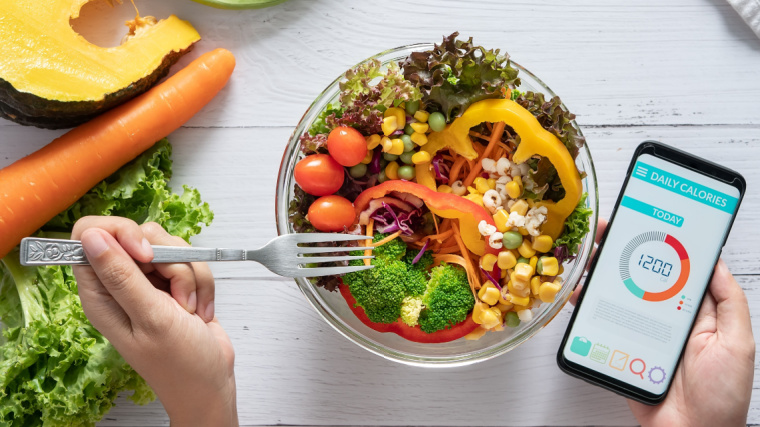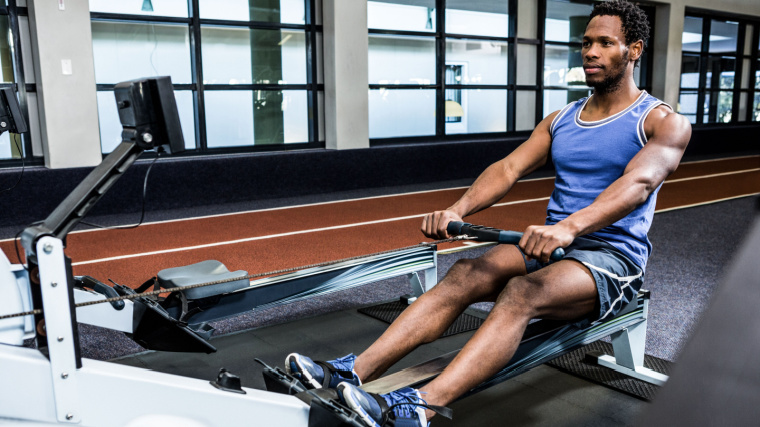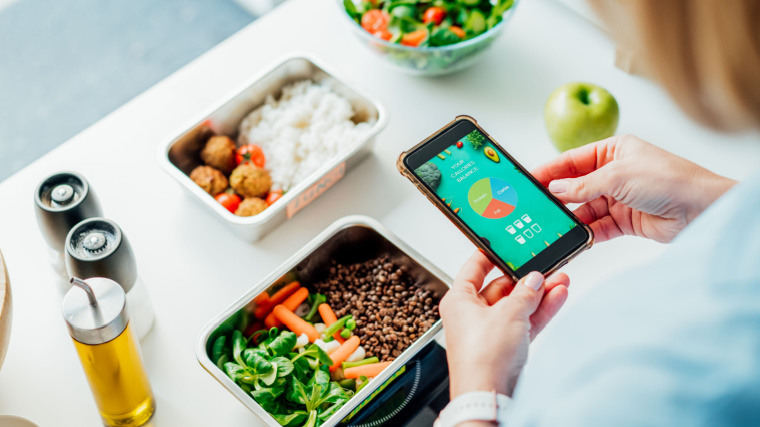If you’re in the fitness world, you can’t avoid it: whether in your gym locker room or scrolling on Instagram, it seems that everyone has something to say about nutrition. A favorite topic among bodybuilders and social media influencers alike is how many calories you should eat a day.
Despite the trends you might be tempted to hop on board with, It’s simply energy balance that dictates your weight — energy in versus energy out — along with an array of other factors impacting what food you have access to and how your body processes it.

And it’s not just about losing, gaining, or maintaining weight. You can’t feel or perform your best if you aren’t fueling yourself properly. When you know how much energy your body needs, you can make informed decisions about your energy intake in the pursuit of your fitness goals. So, how many calories do you need, and how will you know you’re eating the right amount?
- What Are Calories?
- How to Decide How Many Calories You Should Eat?
- How Many Calories Should You Eat for Performance or Health Goals?
- How Many Calories Should You Eat for Physique Goals?
- Our Calorie Calculator
- Frequently Asked Questions
Editor’s Note: The content on BarBend is meant to be informative in nature, but it should not be taken as medical advice. When starting a new training regimen and/or diet, it is always a good idea to consult with a trusted medical professional. We are not a medical resource. The opinions and articles on this site are not intended for use as diagnosis, prevention, and/or treatment of health problems. They are not substitutes for consulting a qualified medical professional.
What Are Calories?
Calories are units of energy measurement, in the same way that degrees are units of temperature measurement and centimeters and inches are used to measure distance. (1)
The energy from our food is stored in the chemical bonds between the carbon, hydrogen, oxygen, and nitrogen atoms that make up the macronutrients — carbohydrates, fats, and proteins.
Fats are the most energy-dense macronutrient because they contain nine kilocalories (kcal) per gram, whereas carbs and proteins contain only four kcal per gram. (2)
[Read More: The Best Healthy Fast Food Options at the Most Popular U.S. Chains]
The cells in our bodies use most of the chemical energy from food to form adenosine triphosphate (ATP), which is often referred to as the “energy currency” of the cell since it powers everything from the nervous system to muscular contractions.
Some of the chemical energy is lost as heat, which helps to maintain body temperature, and excess energy is stored for later use in the form of glycogen and body fat. (2)(3)
How to Decide How Many Calories You Should Eat?
Your daily calorie intake needs depend on several factors such as your age, body composition, and physical activity level. Your actual amount of calories you take in is based on your goals — whether you want to lose weight, gain weight, or maintain your current weight.
When you consume fewer calories than your body needs, you enter a calorie deficit, or a state of negative energy balance that may result in (mostly) fat loss. When you consume more than your body needs, some of the excess energy can be used to build muscle mass, and a portion is stored in the form of body fat. (2)(3)
What Burns Calories?
Your body needs a certain amount of energy — or calories — to keep you alive and support your everyday activities. The total amount of energy you require to keep your vital organs functioning, process and absorb nutrients, and engage in physical activities is known as your Total Daily Energy Expenditure (TDEE).
Your TDEE includes three components:
- Basal Metabolic Rate (BMR): This represents the calories your body needs to carry out essential functions, such as breathing and maintaining body temperature, without any physical activity.
- Thermic Effect of Food (TEF): TEF accounts for the calories your body spends to digest and absorb nutrients from the food you eat.
- Physical Activity: This category includes all types of movement, ranging from everyday activities like getting out of bed to more structured exercise routines at the gym. Included in this category is NEAT — non-exercise activity thermogenesis, which involves activities like walking around your house, fidgeting, and doing the dishes. You also have EAT — exercise activity thermogenesis, which refers to intentional, structured exercises like treadmill running, lifting weights, and cycling.
Your BMR constitutes the largest portion of your TDEE. TEF typically contributes only 10 to 15 percent of your TDEE, while the role of physical activity can vary significantly based on your activity level. Your level of physical activity is the sole aspect of your TDEE that you have full control over. (2)(3)

[Read More: The Best Foods for Energy Before, During, and After Your Workouts]
So, if you’re aiming to increase your TDEE, you may opt to not just exercise more, but also move more during the day. That might include a 10-minute walk every two hours, taking the stairs instead of an escalator, or hand mixing that dough instead of using a stand mixer.
What Factors Influence Your Daily Calorie Needs?
Everything from age, sleep, and hormonal levels to genetics and environmental factors like access to affordable healthy food impacts how your body processes calories. Your food choices can also influence your calorie needs since they affect your TEF.
Calorie Needs Vary with Age and Stages of Life
BMR is highest (relative to body mass) in infants, but steadily declines until about age 20, where it remains relatively stable for the next 40 years. BMR declines in older adults, but that’s likely due to the loss of muscle mass rather than age. People also tend to become more sedentary with age, so they don’t burn as many calories through physical activity. (3)
It’s important to note that there’s no reason to believe that you have to lose muscle mass as you age. You can work with a nutritionist or another qualified healthcare professional to improve your wellness and activity level if you want to retain muscle mass and strength as you get older.

[Read More: Nutrition for Athletes — How to Eat for Muscle and Performance]
Both BMR and TDEE are higher during pregnancy and chest or breastfeeding, equating to several hundred additional calories per day. (3)
Calorie Needs Are Relative to Body Size and Muscle Mass
That brings us to the next factors: body size and body composition. All things being equal, people with larger bodies, higher levels of muscle mass, or people with obesity will also have higher BMRs. Fat mass can also contribute to BMR. (3)
[Read More: The 12 Best Supplements for Muscle Growth]
Rapid weight loss can result in adaptive thermogenesis, which reduces BMR, but even with gradual weight loss, a smaller body will have a lower BMR. Genetics can also affect BMR since they influence body composition and mitochondrial function. (3)
Calorie Needs Are Greater in Physically Active People
This one may be obvious, but the more physically active you are, the more energy you need to consume to maintain a healthy weight.
[Read More: 5 At-Home Workouts for Strength, Muscle Growth, Power, and More]
That’s not just because you’re burning more calories through exercise. You may also have a higher TEF than people who are sedentary, so you require more calories to digest and absorb your meals. (3) If you’re seeking guidance about how to balance your calorie consumption and activity factors, consider checking in with a registered dietitian (RDN).
Meal Composition Affects TEF
Protein has the highest TEF of the macronutrients — meaning it takes the most energy to digest — whereas the TEF of carbohydrates and fats is quite low. That doesn’t mean you should reduce or eliminate carb or fat intake to try and manipulate your TEF. Make sure you’re following relevant dietary guidelines to ensure you’re getting enough of all the macronutrients.

[Read More: The Best Protein Intake Calculator for Muscle Gain and Fat Loss]
There’s also evidence that minimally processed, high-fiber meals result in a higher TEF and more energy being lost in stool. All other factors controlled, a person eating a high-protein, plant-rich dietary pattern would likely have greater calorie needs than someone eating a low-protein, low-fiber diet. (3)(4)
How Many Calories Should You Eat for Performance or Health Goals?
If you’re an athlete or fitness enthusiast, you know that there’s no way to optimize performance when you’re in poor health. Eating too few calories can result in Relative Energy Deficiency in Sport (RED-S) syndrome. (5) RED-S has serious health and performance consequences, including:
- Impaired immunity, protein synthesis, cardiovascular health, and menstrual function
- Increased risk of illness, injury, and stress fractures
- Inability to recover and respond to training stimuli
- Psychological distress, difficulty concentrating, and lack of coordination
If you’re a health enthusiast hitting the gym most days of the week, your calorie needs probably fall within 25 to 35 kcal per kilogram (kg) of body weight per day. That intake will support your health (assuming you’re following a prudent dietary pattern), recovery, and performance. (6)
[Read More: Omega 3 Benefits — More Muscle, Better Recovery, and Enhanced Endurance]
If you’re a competitive athlete training for two to three hours a day, you’ll likely need upwards of 50 to 80 kcal/kg of body weight per day to prevent RED-S. Elite endurance athletes training for three to six hours a day could need up to 150 kcal/kg of body weight per day! (6)
How Many Calories Should You Eat for Physique Goals?
Many people have purely aesthetic goals, but it’s important to differentiate the approach of a physique athlete from that of a fitness enthusiast.
Physique athletes, like bodybuilders, are judged entirely on aesthetics. A physique athlete may reduce their calories from 2,000 to 3,800 in the off-season to as little as 1,600 (or even less) while preparing for a competition. They sacrifice performance — and, to some extent, health — in pursuit of an exceptionally lean, muscular physique that lasts just a few days. (7)
Some athletes and gymgoers — inspired by social media fitness content — use similarly extreme measures in pursuit of aesthetic goals that they hope to maintain indefinitely, which may be unrealistic and even harmful. In reality, fat loss, muscle gain, and body recomposition can all be achieved with relatively small deviations from your daily calorie needs. (8)

[Read More: The Definitive Guide to Bodybuilding Meal Prep]
When you’re interested in gaining muscle, you can achieve that by eating 300 kcal/day more than you need to maintain your current weight. (9)(10)
If your goal is losing fat without losing an unnecessary amount of muscle mass, eat up to 500 kcal/day less than you need to maintain your current weight. And if you want to build muscle and spur fat loss somewhat simultaneously, eat what you need to maintain your weight. (9)(10)
Our Calorie Calculator
If you’ve weighed the pros and the cons of tracking calories and decided that it’s the right method for you, check out BarBend’s very own calorie calculator.
Calorie Calculator
Age
Sex
Height
Weight
Activity Level
BMR estimation formula
Keep in mind that this is an estimate to help you get started, but you’ll likely need to adjust your caloric intake based on your weight change or biofeedback.
Keep Track of Your Goals
So how many calories should you eat a day? Alas, there’s no single answer. The number of people there are in the gym is equivalent to the number of different caloric intake requirements that are present.
The amount of calories you need depends on a wide array of factors, ranging from activity level and age to your fitness goals. Consider consulting with a qualified healthcare professional like a registered dietitian or nutritionist if you want the most highly personalized recommendation for your caloric needs.
FAQs
Calorie intake is a complex topic. Don’t worry — we’ve got answers for you.
Do I have to count calories?
Calorie counting can be a useful, educational tool, but it isn’t a requirement for every health or fitness enthusiast. Other options include plate-planning and using intuitive eating practices like listening to your body’s cues of hunger, fullness, fatigue, and recovery to autoregulate your energy intake.
What are the risks and benefits of counting calories?
Calorie counting is efficient and straightforward, much like using GPS to reach a destination. It can provide education and insights about the energy density and macronutrient content of foods and portion sizes. However, it can contribute to psychological distress and disordered eating, so it isn’t appropriate for everyone. (11)
How do I know I’m eating the right number of calories?
If you’re tracking your weight while pursuing weight change, you should see a trending average loss or gain throughout one to two weeks. If you’re weight stable for a couple of weeks, you’re likely eating enough calories to maintain your weight, which may be too many or too few depending on your goal. If you’re aiming for maintenance and your average weight is changing, you may also be eating too many or too few calories.
If you’re not tracking your weight or calories, you can be aware of your hunger, fullness, fatigue, performance, and recovery to determine whether you’re eating the right amount for your goals.
What are the risks of eating too many or too few calories?
Excess energy — that is, extra calories — can be used to build muscle mass, which supports both health and performance. It could also contribute to added body fat, which may or may not improve someone’s health or performance. Weight-class athletes may also need to consider how weight gain will affect their performance and competitive advantage.
Eating too few calories can lead to the negative health and performance consequences of RED-S. Not only will your performance, recovery, and mental health suffer, but you’ll also be at greater risk of injuries or illnesses that will prevent you from training at all.
References
- Hargrove J. L. (2007). Does the history of food energy units suggest a solution to “Calorie confusion”?. Nutrition journal, 6, 44.
- Espinosa-Salas, S., & Gonzalez-Arias, M. (2023). Nutrition, Macronutrient Intake. In: StatPearls [Internet]. Treasure Island, FL: StatPearls Publishing.
- National Academies of Sciences, Engineering, and Medicine; Health and Medicine Division; Food and Nutrition Board; Committee on the Dietary Reference Intakes for Energy. (2023, January 17). Dietary Reference Intakes for Energy. Washington, DC: National Academies Press (US). Chapter 4: Factors Affecting Energy Expenditure and Requirements.
- Hall, K. D., Ayuketah, A., Brychta, R., Cai, H., Cassimatis, T., Chen, K. Y., Chung, S. T., Costa, E., Courville, A., Darcey, V., Fletcher, L. A., Forde, C. G., Gharib, A. M., Guo, J., Howard, R., Joseph, P. V., McGehee, S., Ouwerkerk, R., Raisinger, K., Rozga, I., … Zhou, M. (2019). Ultra-Processed Diets Cause Excess Calorie Intake and Weight Gain: An Inpatient Randomized Controlled Trial of Ad Libitum Food Intake. Cell metabolism, 30(1), 67–77.e3.
- Mountjoy, M., Sundgot-Borgen, J. K., Burke, L. M., Ackerman, K. E., Blauwet, C., Constantini, N., Lebrun, C., Lundy, B., Melin, A. K., Meyer, N. L., Sherman, R. T., Tenforde, A. S., Klungland Torstveit, M., & Budgett, R. (2018). IOC consensus statement on relative energy deficiency in sport (RED-S): 2018 update. British journal of sports medicine, 52(11), 687–697.
- Kreider, R. B., Almada, A. L., Antonio, J., Broeder, C., Earnest, C., Greenwood, M., Incledon, T., Kalman, D. S., Kleiner, S. M., Leutholtz, B., Lowery, L. M., Mendel, R., Stout, J. R., Willoughby, D. S., & Ziegenfuss, T. N. (2004). ISSN Exercise & Sport Nutrition Review: Research & Recommendations. Journal of the International Society of Sports Nutrition, 1(1), 1–44.
- Roberts, B. M., Helms, E. R., Trexler, E. T., & Fitschen, P. J. (2020). Nutritional Recommendations for Physique Athletes. Journal of human kinetics, 71, 79–108.
- Alberga, A. S., Withnell, S. J., & von Ranson, K. M. (2018). Fitspiration and thinspiration: A comparison across three social networking sites. Journal of Eating Disorders, 6, 39.
- Slater, G. J., Dieter, B. P., Marsh, D. J., Helms, E. R., Shaw, G., & Iraki, J. (2019). Is an Energy Surplus Required to Maximize Skeletal Muscle Hypertrophy Associated With Resistance Training. Frontiers in nutrition, 6, 131.
- Barakat, C. M. S., Pearson, J. M., Escalante, G. D., Campbell, B. P., & De Souza, E. O. (2020). Body recomposition: Can trained individuals build muscle and lose fat at the same time?. Strength and Conditioning Journal, 42(5), 7-21.
- Simpson, C. C., & Mazzeo, S. E. (2017). Calorie counting and fitness tracking technology: Associations with eating disorder symptomatology. Eating behaviors, 26, 89–92.
Featured Image: asiandelight / Shutterstock
The post How Many Calories Should I Eat Per Day? A Guide for All Your Fitness Goals appeared first on BarBend.
